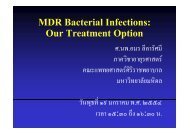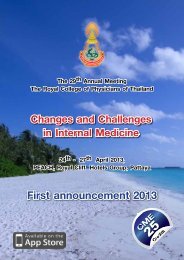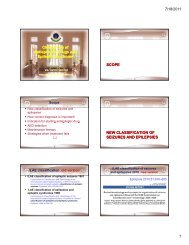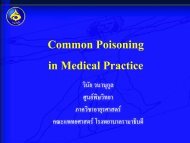Approach to Headache
Approach to Headache
Approach to Headache
- No tags were found...
Create successful ePaper yourself
Turn your PDF publications into a flip-book with our unique Google optimized e-Paper software.
<strong>Approach</strong> <strong>to</strong> <strong>Headache</strong>Prof. Kammant PhanthumchindaChulalongkorn University
Pain sensitive structures• Intracranial:dura, lep<strong>to</strong>meninges, large artery & vein• Paracranial structures:skull & scalp, sinus, eyes, neck, etc.• Referred pain:cardiovascular systemneck
Mechanisms of pain• Irritation & inflammation of pain sensitive structures• Traction of pain sensitive structures– Mass– Intracranial hypertension– Intracranial hypotension• Vascular pain– Collateral circulation– Venous pressure– Toxic vascular cause
Mechanisms of pain• Pressure in paracranial structures:– sinus, intraocular pressure• Neuralgic pain• Neuronal hyperexcitibility• Other mechanisms– Muscle-joint mechanism– Iatrogenic mechanism– Psychogenic mechanism
Sources of pain• Local disease– Superficial-deep structure• Referred pain–Intracranial• Lep<strong>to</strong>meinges-pachymeninges• Supraten<strong>to</strong>rium -CN V• Infraten<strong>to</strong>rium – Cervical root–Extracranial• Neck• Mediastinum
Area of PainLocalized painUnilateral painDiffuse•Small area:- paracranial structure•Unilateral•Bilateral•Large area:- intracranial structure•primary headache•Meningeal pain•Increased intracranial pressure•Low intracranial pressure•Toxic vascular headache•Primary headache
Localized headache• Maxillary division– Posterior ethmoidnerve– Posterior septum,parts of superior andmiddle turbinates• Ophthalmic division• Greater superficialpetrosal nerve
Unilateral headahe• Localized headache supplyby V1 or C2• Increased intracranialpressure• Focal neurological deficit
Classification of headache• Primary headache (functional headache)– Migraine– Tension- type– Cluster headache– Myofascial pain– Others• Secondary headache (organic headache)– Intracranial causes– Paracranial causes– Systemic diseases
Characters of primary headache• Recurrent attacks• Symp<strong>to</strong>ms free between the attacks• Pain shift in side and location• Clinical syndromes fulfill IHS* criteria• Physical examination normal• No organic causes• Exception: drug-abuse headache*International <strong>Headache</strong> Society
Characters of secondary headache• Progressive course• Symp<strong>to</strong>ms persist• Pain select <strong>to</strong> ana<strong>to</strong>mical lesions• Side-locked• Physical examination usually abnormal
Characters of secondary headacheExceptions– Some ana<strong>to</strong>mical lesions :pain can shift notside-locked• Sella, parasella• Sinus• Venous sinus– Some physiological mechanisms : symp<strong>to</strong>mfree period may occur• Fluctuation of intracranial pressure• Dynamic flow in vascular system• Multiple intraventricular cystic lesions
.uperior sagittal sinus thrombus
Spontaneous low CSF pressure
Dural AVM
Pituitary lesion
Intraventricular lesions
Cervical spine lesion
Evaluation of headache• His<strong>to</strong>ry• Physical examination– Neurological examination– General physical examination• Investigations• Criteria for diagnosis of headache
His<strong>to</strong>ry• Location of pain– Diffuse– focal– Constant– Spreading• Natural his<strong>to</strong>ry of pain wave– Fluctuation, constant,peak– Symp<strong>to</strong>m free period– Time of day– Associated symp<strong>to</strong>ms– Radiation of pain– Migration– Shifting– Secondary pain• myofascial pain• allodynia• sympatheticchange
His<strong>to</strong>ry• Severity of pain• Characters of pain– Throbbing– Neuralgic– Dull aching– etc.• Precipitating and aggravating fac<strong>to</strong>rs• Relieving fac<strong>to</strong>rs & response <strong>to</strong> medications• Other neurological & systemic symp<strong>to</strong>ms
Physical Examination• Systemic– Hypertension– Fever– Focal mass lesion– Bleeding tendency–HIV• Neurological examination– Cranial nerves & eye ground– Other neurological examination– Cranial bruit• Paracranial structures – eye, ear, nose• Correlation of headache & physical findings
Secondary headache– X-ray - Sinus–CT-Scan–MRI–ESR-Neck– Other labora<strong>to</strong>ryInvestigations• Correlation of headache & labora<strong>to</strong>ry findings
Treatment• Secondary headache– Symp<strong>to</strong>matic treatment– Specific treatment for causes• Primary headache– Acute treatment– Preventive treatment• Medical treatment• Non-medical treatment
Eur J Neurol. 2004;11(9):577-81Evidence-based medicine• Rating of recommendation– Level A rating (established as effective, ineffective, orharmful) requires• at least 1 convincing class I study or• at least 2 consistent, convincing class II studies– Level B rating (probably effective, ineffective, or harmful)requires• at least 1 convincing class II study or• overwhelming class III evidence– Level C rating (possibly effective, ineffective, or harmful)requires• at least 2 convincing class III studies– Level U rating (data inadequate or conflicting, given currentknowledge, treatment is unproven) requires• class IV studies
Migraine
Migraine Syndrome• Premoni<strong>to</strong>ry phase– Mental-Hypothalamic-Au<strong>to</strong>nomic syndrome• Aura phase– Neurological syndrome• <strong>Headache</strong> phase– Migration and increase in severity of headache– Associated symp<strong>to</strong>ms: nausea, vomiting, pho<strong>to</strong>phobiaphonophobia• Resolution phase– Subsided of headache– Reversed of premoni<strong>to</strong>ry phase
Overview of migraine phenomena– Onset – gradual• Prodrome – Hours - days• Aura - onset <strong>to</strong> peak 5 <strong>to</strong> 40 minutes- last 5 <strong>to</strong> 60 minutes- visual aura may be abrupt and short duration in non headache attack– Duration of headache• 4-72 hours– Progression – migration of head pain and marching of aura– Postdrome – gradual– Content• Positive = negative phenomena (except mo<strong>to</strong>r usually negative)• Au<strong>to</strong>nomic – behavioural syndrome – common• Brainstem syndrome – occasionally (except vertiginous syndrome common)• Aggravating – precipitation fac<strong>to</strong>r - common
Premoni<strong>to</strong>ry symp<strong>to</strong>ms (prodrome(prodrome)Mental manifestationsDepressedHyperactiveEuphoricTalkativeIrritableRestlessDifficulty concentratingSluggishnessDrowsyHyperosmiaHypothalamic au<strong>to</strong>nomic manifestationsYawningCold feelingFood cravingsAnorexiaDiarrheaConstipationThirstUrinationRetention
Aura – Neurological syndromeTypical auraVisualScintillating sco<strong>to</strong>maHemianopiaBlindnessBlurring of visionParaesthesiaAphasiaCombinedOther auraHemiplegiaBrainstem symp<strong>to</strong>mDysarthriaOphthalmoplegiaNystagmusOther auraOculosympathetic palsyMydriasisConfusion-stuporDizzinessCyclical vomitingSeizureDeafnessRecurrent of old strokedeficit
Scintillation sco<strong>to</strong>ma
Visual aura
Migraine sensory and visualaura
Migraine headache• Unilateral or bilateral location• Meningeal pain syndrome• Migra<strong>to</strong>ry of pain• Shifting of side in various attacks• Pulsating quality• Moderate or severe intensity (inhibit or prohibit dailyactivities)• Aggravated by walking stairs or similar routine physicalactivities• <strong>Headache</strong> lasts 4-72hr (untreated or unsuccessfullytreated)
Associated phenomena• Nausea• Pho<strong>to</strong>phobia• Dizziness• Phonophobia• Osmophobia• Allodynia– Pain from non-noxious heat, cold or pressure–Site• Trigeminal• Cervical• Rest of body
Postdrome• Reverse of prodrome– Feel tired - hyperactive– Irritable - sluggishness– Unusually refreshed – drowsy– Anorexia – food cravings– Diarrhea – constipation– Edema – urination– Other nonspecific symp<strong>to</strong>ms
Aggravating fac<strong>to</strong>rs• Diet– Hunger– Alcohol– Additives– Certain foods• Chronobologics– Sleep (<strong>to</strong>o much or <strong>to</strong>o little)– Schedule change• Hormonal change– Menstruation• Environmental fac<strong>to</strong>rs– Light glare– Odors– Altitude– Weather change• Head or neck pain of another cause• Physical exertion– Exercise– Sex• Stress and anxiety• Head trauma• Relieving fac<strong>to</strong>rs– Sleep– Dark environment– Quiet environment
Diagnosis of migraine• International <strong>Headache</strong> Society (IHS) classificationof headache system• To diagnose migraine, secondary headache causesis necessary <strong>to</strong> be excluded and other coexistingmedical problem should be considered• Coexisting primary headache e.g. tension type ofheadache should determined• Diagnostic testing may be recommended at anindividual level
Migraine without auraDiagnostic criteria:A. At least 5 attacks fulfilling criteria B-DB. <strong>Headache</strong> attacks lasting 4-72 hours (untreated or unsuccessfully treateC. <strong>Headache</strong> has at least two of the following characteristics:1. unilateral location2. pulsating quality3. moderate or severe pain intensity4. aggravation by or causing avoidance of routine physical activity(eg, walking or climbing stairs)D. During headache at least one of the following:1. nausea and/or vomiting2. pho<strong>to</strong>phobia and phonophobiaE. Not attributed <strong>to</strong> another disorder
Migraine with auraDiagnostic criteria:A. At least 2 attacks fulfilling criteria B–DB. Aura consisting of at least one of the following, with or without speechdisturbance but no mo<strong>to</strong>r weakness:1. fully reversible visual symp<strong>to</strong>ms including positive features (eg,flickering lights, spots or lines) and/or negative features (ie, loss ofvision)2. fully reversible sensory symp<strong>to</strong>ms including positive features (ie,pins and needles) and/or negative features (ie, numbness)C. At least two of the following:1. homonymous visual symp<strong>to</strong>ms and/or unilateral sensorysymp<strong>to</strong>ms2. at least one aura symp<strong>to</strong>m develops gradually over ≥5 minutesand/or different aura symp<strong>to</strong>ms occur in succession over ≥5minutes3. each symp<strong>to</strong>m lasts ≥5 and ≤60 minutesD. <strong>Headache</strong> does not occur during aura nor follow aura within 60minutesE. Not attributed <strong>to</strong> another disorder
Treatment of Migraine
Keys for Management• Correct diagnosis• Appropriate investigations• Proper choices of symp<strong>to</strong>matic and preventivemanagement• Prevention and treatment of migraine progression• Critical evaluation and follow-up
Target of acute treatment
EFNS guideline on the drug treatment of migraineSubstanceDoseLevelCommentAcetylsalicylic acid (ASA)1000 mg (oral)1000 mg (intravenous [i.v.])AAGastrointestinal side effects, risk ofbleedingIbuprofen200 – 800 mgASide effects as for ASANaproxen500 – 1000 mgASide effects as for ASADiclofenac50 – 100 mgAIncluding diclofenac-KParacetamol1000 mg (oral)1000 mg (supposi<strong>to</strong>ry)AACaution in liver and kidney failureASA plus, paracetamol plusand caffeine250 mg (oral),200 – 250 mg and 50 mgAAs for ASA and paracetamolMetamizol1000 mg (oral)1000 mg (i.v.)BBRisk of agranulocy<strong>to</strong>sisRisk of hypotensionPhenazon1000 mg (oral)BSee paracetamolTolfenamic acid200 mg (oral)BSide effects as for ASARating of RecommendationsLevel A rating (established as effective, ineffective, or harmful) requires at least one convincing class I study or at leasttwo consistent, convincing class II studies. Level B rating (probably effective, ineffective, or harmful) requires at least oneconvincing class II study or overwhelming class III evidence. Level C rating (possibly effective, ineffective, or harmful)requires at least two convincing class III studies.
EFNS guideline on the drug treatment of migraine - triptansSubstanceDoseLevelCommentSumatriptan25, 50 and 100 mg (oral including rapidrelease)25 mg (supposi<strong>to</strong>ry) A 100 mg sumatriptan is reference <strong>to</strong> alltriptans10 and 20 mg (nasal spray)AA6 mg (subcutaneous)AZolmitriptan2.5 and 5 mg (oral including disintegratingform)2.5 and 5 mg (nasal spray)AANaratriptan2.5 mg (oral)ALess but longer efficacy than sumatriptanRizatriptan10 mg (oral including wafer form)A5 mg when taking propranololAlmotriptan12.5 mg (oral)AProbably less side effects than sumatriptanEletriptan20 and 40 mg (oral)A80 mg allowed if 40 mg not effectiveFrovatriptan2.5 mg (oral)ALess but longer efficacy than sumatriptanRating of RecommendationsLevel A rating (established as effective, ineffective, or harmful) requires at least one convincing class I study or at leasttwo consistent, convincing class II studies. Level B rating (probably effective, ineffective, or harmful) requires at least oneconvincing class II study or overwhelming class III evidence. Level C rating (possibly effective, ineffective, or harmful)requires at least two convincing class III studies.
Triptans – onset and half-lifeOnset ofactionDrugTime <strong>to</strong> peak plasma(h)Half life (h)Sumatriptan2.52Zolmitriptan3.32.5-3.0FastRizatriptan1.22.0-3.0Almotriptan1.4-3.83.2-3.7Eletriptan1.0-2.03.6-5.5SlowNaratriptanFrovatriptan2.0-3.02.0-4.05.0-6.325Tepper SJ. Acute treatment of migraine. Continuum 2006;12:87-105
New coming agentsClassCompoundStudy phaseResultCGRP antagonistOlcegepant (BIBN4096)Phase III clinicalEffective(parenteral use only)CGRP antagonistTelcagepant (MK-0974)Phase III clinicalEffectiveTRPV1 antagonist:SB-705498Phase II(non-migraine pain)EffectiveEP4 recep<strong>to</strong>rantagonistCJ-023423BGC20-1531Pre-clinicalVasoconstriction5-HT1F agonistLY334370Phase IIIEffective(Study suspended due <strong>to</strong> nonhuman<strong>to</strong>xicity)Nitric oxide inhibi<strong>to</strong>rs546C88Phase IIEffectiveNitric oxide inhibi<strong>to</strong>rsGW274150GW 273629PreclinicalEffective
Indication for Migraine prophylaxis1. Two or more attacks a month that produce disability2. Failure of, contraindication <strong>to</strong> or troublesome sideeffects from acute medication3. Very frequent headaches (> 2/week) with the risk ofrebound headache4. Overuse of acute medications5. Patient preference6. Special circumstances- Hemiplegic migraine- Basilar migraine- Migraine with prolonged aura- Migrainous infarction
Episodic migraine preventive treatmentRating ofrecommendationDrug Comorbidity Contraindicationvel AAntidepressantsAmitriptyline 10-150 mgBeta-blockersPropanolol 40-320 mg,me<strong>to</strong>prolol 50-200 mg(betaloc)Depression, anxiety,insomnia, other painHTN, angina, Anxiety, tremorGlaucoma, obesity,mania, BPH, heartblock, epilepsy, bipolaDepression, Asthma,CHF, heart block, DM,Raynaud’s, obesityCalcium antagonistsFlunarizine 5-10 mgAntiepileptic drugsValproic acid 500-1500mgTopiramate 50-200 mgHTN, vertigo, angina,Raynaud’sMania, anxiety, bipolar,epilepsyMania, anxiety, bipolar,epilepsy, Obesity, tremorDepression, PD,obesityLiver disease, bleedingdisorder, obesity,tremorKidney s<strong>to</strong>nes,Glucoma, memoryimpairment
Rating ofrecommendationEpisodic migraine preventive treatmentDrug Comorbidity Contraindicationevel BAntidepressantsSSRI: fluoxetine 10-80 mgDepression, anxiety,insomnia, other painmania, epilepsy, liver orhepatic disease, heartblockBeta-blockersAtenolol 50-200 mg, bisoprolol5-10 mg (concor)HTN, angina, Anxiety,tremorAsthma, CHF, heartblock, DM, Raynaud’sCalcium antagonistsVerapamil 120-640 mg,nimodipine 60-120 mgAntiepileptic drugsGabapentin 600-2400 mgNSAIDsHTN, vertigo, angina,Raynaud’sEpilepsy, tremor,other painHeart block,hypotension, liverdiseaseCKDASA 300 mg, Naproxen 500-1000 mg, Ke<strong>to</strong>profen 150 mgOthersMg2+ 600 mg, B12 400 mg
Tension-type headache
Prior terminology for TTH• Ordinary headache • Stress headache• Essential headache • Depressive headache• Idiopathic headache • Anxiety headache• Muscle contraction • Psychogenic headacheheadache• Conversion headache• Psychomyogenic headache• Soma<strong>to</strong>form disorder• Tension headacheheadache
General clinical features oftension-type type headache• Pure tension-type headache• Bilateral, non-throbbing, plus absence of nausea,vomiting, pho<strong>to</strong>phobia, phonophobia, movementexacerbation• Tension-type headache is seen in migraine• Probable mild migraine
Association of tension-typetypeheadache and muscle contraction• Pericranial muscle disorder– Increased tenderness of pericranial muscles– Increased level of electromyographic (EMG) activities• Tension-type headache– Associated with disorders of pericranial muscles– Not associated with disorder of pericranial muscles
Pericranial tenderness• Frontalis• Temporalis• Lateral and medial pterygoid• Messeter• Sterocleidomas<strong>to</strong>id• Trapezius
Pericranial muscle
Subtypes of tension-typetypeheadache1. Infrequent episodic tension-type headache1.At least 10 episodes occurring on < 1day per monthon average (
Character of tension-typetypeheadacheC. <strong>Headache</strong> has at least two of the followingcharacteristics:1. Bilateral location2. Pressing/tightening (non-pulsating) quality3. Mild or moderate intensity4. Not aggravated by routine physical activitysuch as walking or climbing stairs
Character of tension-typetypeheadacheD. Both of the following:1. No nausea or vomiting (anorexiamay occur)2. No more than one of pho<strong>to</strong>phobia orphonophobiaE. Not attributed <strong>to</strong> another disorder
Abortive therapy for episodic tension-typeRating of recommendationDrugvel ANSAIDsAcetaminophen 1000 mg,ASA 1000 mg, Ibuprofen 200-400 mg, diclofenac 12.5-25 mg, naproxen220-500 mg, metamizole 500-1000 mg, ke<strong>to</strong>profen 12.5-50 mgCombination drugsIbuprofen 400 mg + caffeine 200 mg (NA)vel Bvel UNSAIDsmefenamic acid 250 mg, nimesulide (nidol)Metamizole 1000 mg iv, Ke<strong>to</strong>rolac 60 mg imCOX-2 inhibi<strong>to</strong>rLumiracoxib 200, 400 mg (withdrawn)Combination drugsAcetaminophen 325 mg + caffeine 40 mg (NA)indomethacin + prochlorperazine + caffeine (NA)OthersChlorpromazine 0.1 mg/kg ivMuscle relaxants, Opioids, sedatives
Prophylactic therapy treatment ofepisodic tension-typetypeRating ofrecommendationevel CDrug Comorbidity ContraindicationTCA: Amitriptyline 25 mgSSRI: Fluoxetine 20 mgSNRI: Venlafaxine XR 150mg,mirtazapine 15-30 mgDepression, anxiety,insomnia, other painDepression, anxiety,insomnia, other painDepression, anxiety,panicdepressionGlaucoma, obesity, mania,BPH, heart block, epilepsy,bipolarmania, epilepsy, liver orhepatic disease, heart blockMania, epilepsy, recent MI,severe HTN, liver, kidneydiseaseGlaucoma, liver, kidneydisease, cardiac disease,epilepsy, DM, schizophreniapsychosisAmitriptyline + tizanidineadjunctive therapy
Trigeminal au<strong>to</strong>nomiccephalalgia
Trigeminal au<strong>to</strong>nomic cephalalgia• Cluster headache– Episodic/chronic cluster headache• Paroxysmal hemicrania– Episodic/chronic Paroxysmal hemicrania• Short-lasting unilateral neuralgiform headache attacks withconjunctival and tearing (SUNCT)• Probable trigeminal au<strong>to</strong>nomic cephalalgia
Clinical features of Trigeminalau<strong>to</strong>nomic cephalalgia• <strong>Headache</strong>– Orbital– Supraorbital–Temporal• Parasympathetic stimulation–Lacrimation– Conjunctival injection– Nasal congestion• Sympathetic signs– Horner’s syndrome
Mechanism of Trigeminal au<strong>to</strong>nomiccephalalgia• Activation of trigeminal brainstem complex• Au<strong>to</strong>nomic nervous system involvement• Hypothalamic mechanism
Common features• Headche– Orbital, supraorbital, temporal area• Prominent Cranial parasympathatic features– Conjunctival injection– Lacimation–etc
Mechanism• Activating of Trigeminal parasympathatic reflex• Secondary clinical signs of cranial sympathaticdysfunction• Hypothalamic genera<strong>to</strong>r
Cluster headacheDiagnostic criteriaA. At least 5 attacks fulfilling criteria B-DB. Severe or very severe unilateral orbital, supraorbital and/ortemporal pain lasting 15-180 minutes if untreatedC. <strong>Headache</strong> is accompanied by at least one of the following:1. Ipsilateral conjunctival injection and/or lacrimation2. Ipsilateral nasal congestion and/or rhinorrhea3. Ipsilateral eyelid edema4. Ipsilateral forhead and facial sweating5. Ipsilateral miosis or p<strong>to</strong>sis6. A sense of restlessness or agitationD. Attacks have a frequency from one every other day <strong>to</strong> 8 perdayE. Not attribute <strong>to</strong> another disorder
Differential diagnosis for clusterheadache involves the other knowntrigeminal au<strong>to</strong>nomic cephalgiasFeatureClusterCPHEPHSUNCTGender (M:F)4:11:31:12.3:1Attackduration15–180 min2–30 min1–30 min5–240 sAttackfrequency1–8/day1–40/day3–30/day1/day–30/hAu<strong>to</strong>nomic features++++Alcohol PPT++++Indomethacin effect+/−++−
Abortive therapy treatment ofepisodic cluster headacheRating ofDrugrecommendationevel A 100% Oxygen with flow rate of at least 7L/min in 15minutes via non-rebreathing facial maskTriptans:Sumatriptan 6 mg sc; 20 mg nasal sprayZolmitriptan 5, 10 mg nasal sprayevel BZolmitriptan 5, 10 mg oral4-10% Lidocaine intranasal 1 ccOctreotide 100 micrograms sc
Prophylactic treatment ofepisodic cluster headacheRating ofrecommendationDrug Contraindication Remarkvel AVerapamil 240-960 mgCorticosteroid:Prednisone 60-100 mg/d for at least5 days then taper 10 mg/d until therest of 30 mg/dDexamethasone 2 mg x 4Heart block,hypotension, liverdiseasePU, DM, HTN, CHF,CKD, systemic fungalinfection, TB, glaucoma,psychosisTitration of 40mg/d weeklyTime <strong>to</strong> haveefficacy of 2-3weeksMoni<strong>to</strong>ringECG: PRprolongedvel BLithium carbonate 600-1500 mgMethysergide 6-12 mg (not available)Topiramate at least 100 mgErgotamine 2 mg hsIntranasal civamide 50 micrograms(capsaicin isomer) (not available)CKD, hypothyroidism,CVDMoni<strong>to</strong>ringBlood level,BUN/Cr, LFT,TFT, electrolyte
FIN







